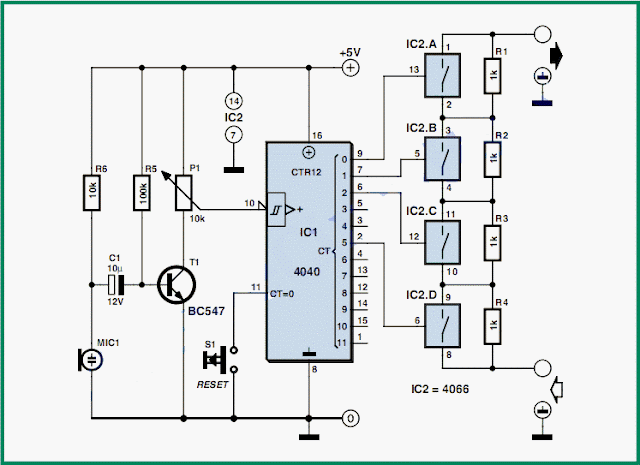Louder music, sirens or speech in response to higher ambient noise levels? This simple circuit has the answer, and it may enable your robot to be at least as noisy or loud-mouthed as the others in an arena. The circuit consists basically of a microphone, a level detector, a 4-state counter and four analogue switches connected to a resistive ladder network. Looking at the circuit diagram, the signal from electret microphone M1 is amplified by T1 whose collector voltage appears across a potentiometer. M1 gets its bias voltage through R4. Depending on the setting of P1, the 4040 counter will get a clock pulse when a certain noise level (threshold) is exceeded.
The counter state determines the configuration of the four electronic switches inside the 4066 and so the series resistance effectively seen in the audio signal line. The circuit should be powered from a 9-V regulated supply or a battery and will consume a few milliamps only. Switch S1 allows the counter to be reset, switching all 4066 switches to off, i.e., the highest attenuation will exist in the audio path as in that case none of the 1-kΩ resistors are shorted out. To calibrate the circuit, disconnect the 4040 clock input (pin 10) from the wiper of P1, and temporarily ground it through a 100 kΩ resistor. Now pulse the clock input by briefly connecting it to the +9 V line; you will see the counter outputs change state and with them, the bilateral switches in the 4066.
The counter state determines the configuration of the four electronic switches inside the 4066 and so the series resistance effectively seen in the audio signal line. The circuit should be powered from a 9-V regulated supply or a battery and will consume a few milliamps only. Switch S1 allows the counter to be reset, switching all 4066 switches to off, i.e., the highest attenuation will exist in the audio path as in that case none of the 1-kΩ resistors are shorted out. To calibrate the circuit, disconnect the 4040 clock input (pin 10) from the wiper of P1, and temporarily ground it through a 100 kΩ resistor. Now pulse the clock input by briefly connecting it to the +9 V line; you will see the counter outputs change state and with them, the bilateral switches in the 4066.
Author: Raj K. Gorkhali Copyright: Elektor Electronics 2007

No comments:
Post a Comment